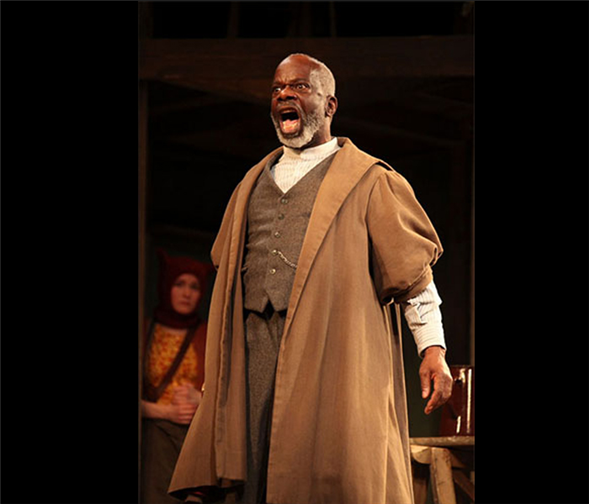New York City is having a King Lear moment. The production of Shakespeare’s tragedy that runs through October 12 at NYU’s Skirball Center is one of several iterations to play the city this year, following stagings at Shakespeare in the Park, Theatre for a New Audience, and BAM.
For a certain type of Shakespeare fan, however, this latest version may be just the thing. It’s a touring production from Shakespeare’s Globe, and everything about it, from the casting to the design, is meant to replicate the spirit of small troupes that toured in the Bard’s time. “Actors toured out of the Globe 400 years ago, and they didn’t only tour the UK; they also toured all over northern Europe,” says Dominic Dromgoole, the Globe’s Artistic Director. “Shakespeare didn’t consider his theatre to be a purely English theatre. He considered it to be a collection of plays that would travel and be happy to travel.”
This production will continue to tour the U.S. through December. “We are performing it in the fashion of how we think it would have been performed by a touring company, with a lot of doubling, with very simple storytelling techniques, and with direct communication between the stage and the audience,” Dromgoole says. “I think the concentration on storytelling takes away a lot of the confusion about the cosmological meaning of the play, which can all be forgotten about because it’s simply about what makes the story clean and clear.”
There are only eight actors in the cast, led by Joseph Marcell (The Fresh Prince of Bel-Air) in the title role. Set and costume designer Jonathan Fensom used illustrations from the period to create his production concept, an Elizabethan-style booth stage. Based on Fensom’s insistence that all materials be authentic or feel authentic, the framework used for the stage is wood, held together by metal brackets and bolts, with a curtain on a rope in the front.
The idea was originally implemented for a touring production of Hamlet. “We discovered we’d created a kind of multi-use classical touring stage that you could do any play on. And so it became interesting for the director of Lear [Bill Buckhurst] to work on the existing stage and he was able to create all sorts of new ideas,” Fensom says. For example, the curtain was used in Hamlet to create a reveal. In this production, it is also used to create a visual element for the storm. “When the audience can see the storm being created, it takes on a journey of imagination,” Fensom says.
The set gets better with time, he adds. “When we first built it, it all looked too new. Since we’ve now been touring for three years, it actually looks better now than it ever did before because it feels like an old stage with a group of players that’s arrived in town and set up in the marketplace.”
Meanwhile, when the audience comes in, they see actors setting up, welcoming spectators, and hanging their costume pieces on pegs. “You let them in to the secret we’re a group of actors, but we’re going to tell you this story and there’s going to come a point in the storytelling when we become the characters and you go along with the journey,” says Fensom.
Each actor wears a simple costume—work trousers, a shirt, and a heavy jacket for the men; well-made, sturdy dresses for the women. Throughout the show, performers differentiate between their various characters by adding simple items like hats and cloaks to their basic garments.
The durability of the costumes is key. “You design the aesthetic, but the aesthetic also has to work within the parameters of a production,” Fensom says. “There would be no point in me designing a white silk dress because you would know it wouldn’t survive.”
Fensom designed a Lear for the Globe’s mainstage in 2008, and he feels the constraints of a small-scale tour have actually made it more fun. “I think there’s an energy to it and an accessibility and a clarity which is sometimes lost in bigger productions, and what I enjoy about it the most is the fact that we’re able to go to places where larger scale productions aren’t,” he says. “It’s allowed us to be more imaginative.”
—
Linda Buchwald tweets about theatre as @PataphysicalSci
Photos by Ellie Kurttz
